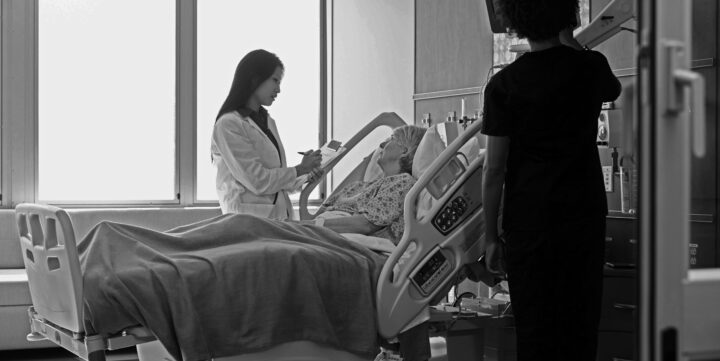Endometriosis and the path to diagnosis
May 23, 2023
The Future Is Bright
Endometriosis is a chronic, debilitating condition affecting approximately one in nine Australian women. Despite its prevalence, historically, its diagnosis has often been delayed, overlooked, or misdiagnosed. A lack of awareness, the normalisation of menstrual pain, and a broad spectrum of symptoms have compounded this problem, resulting in a median diagnosis delay of seven years. However, recent advancements in the Australian health system and clarified role of General Practitioners (GPs) in the mission has been transformative, driving improvements in the diagnostic route for endometriosis sufferers and ensuring a more patient-centric approach.
Endometriosis is a long-term inflammatory disorder characterised by the growth of endometrial-like tissue outside the uterus. In Australia, statistics indicate that about 11.4% of the population is affected by this condition, with individuals aged 30–34 years most commonly diagnosed. The condition leads to around 34,200 hospital admissions per annum, with 95% of these cases involving at least one surgical procedure. Common symptoms include chronic pelvic pain, fatigue, and infertility, though these are not exclusive to endometriosis and could have multiple causes.
Improving Awareness and Education
The launch of the National Action Plan for Endometriosis in 2018 marked a turning point. The National Action Plan for Endometriosis (NAPE) was introduced by the Australian Government, outlining three key areas of focus: education and awareness, clinical care, and research.This governmental initiative aimed to improve the understanding and awareness of endometriosis amongst both healthcare professionals and the wider public. Notably, it recognised the role of GPs as crucial in diagnosing the condition, given they are often the first port of call for women experiencing symptoms.
A major part of this plan is improving medical education and training about endometriosis. This means equipping GPs with the knowledge and tools necessary to identify and manage the condition effectively. These initiatives have facilitated greater awareness about endometriosis, encouraging more women to seek help and enabling earlier identification of potential cases.
Streamlining the Diagnostic Criteria
The diagnostic criteria for endometriosis have also been clarified and simplified. Traditionally, a definitive diagnosis was established via laparoscopy – an invasive surgical procedure following multiple appointments, referrals and rigmorral. However, recently, less invasive diagnostic methods, like ultrasound and MRI, have been increasingly utilised and accepted for the detection of certain types of endometriosis, such as deep infiltrating endometriosis.
While laparoscopy remains the gold standard, the broader acceptance of imaging-based diagnostics has streamlined the diagnostic pathway, especially for cases with advanced disease. This approach reduces the physical and emotional burden on women, while also shortening the time to diagnosis.
Stages of Endometriosis
The American Society for Reproductive Medicine has created a staging system for endometriosis. Endometriosis may be classified as minimal, mild, moderate or severe (or stages one to four). The stages are based on the location, extent and depth of endometrial tissue seen during surgery.
Some research suggests that most women have superficial, or milder, forms of endometriosis, but more research is required in this area.
Stage I (minimal) – there are small endometrial patches or plaques, inflammation and mild adhesions.
Stage II (mild) – as above, but there are many patches and there may be some scarring. There may also be adhesions between the uterus and the rectum.
Stage III (moderate) – as above, but there are also adhesions on the ovaries.
Stage IV (severe) – as above, but there are also many implanted endometrial patches, patches that may form scarred nodules, adhesions to other organs such as the bladder and bowel, and changes to the shape of pelvic organs.
The above classifications are useful, but they don’t always reflect the severity of symptoms. For example, a woman with stage one endometriosis may have more pain than a woman with stage four endometriosis. It should also be noted that if there are fertility problems, a different system called the Endometriosis Fertility Index can be used to help predict pregnancy outcomes following surgery.
National Developments
The Australian Federal Government is set to increase the number of endometriosis and pelvic pain clinics across the nation from 16 to 20, providing specialised multidisciplinary care to more women. Over the next four years, these clinics will receive upwards of $700,000 in funding, which will be utilised to hire nurse practitioners and allied health professionals, invest in equipment, improve pelvic physiotherapy areas, and broaden training and development resources.
Assistant Minister for Health and Aged Care, Ged Kearney, highlighted the significant advancement in women’s health this represents. She emphasised the importance of providing women a platform where they will be believed, appropriately diagnosed, and provided with deserved care for endometriosis and pelvic pain.
The locations for these clinics will span across the country, providing vital support to a significantly under-represented population. This initiative is part of a larger $58.3 million commitment aimed at addressing endometriosis and pelvic pain, given the prevalence of endometriosis in about one in nine Australian women aged 40–44.
EndoZone – personalised Endometriosis support
Despite its prevalence, diagnosis often takes between 7–10 years due to its complex nature. A new digital platform, EndoZone, aims to bridge the knowledge gap and provide support to those living with the condition.
EndoZone was launched by the University of Adelaide’s Robinson Research Institute, backed by joint funding from the Federal Government and Jean Hailes for Women’s Health. The platform provides evidence-based resources and support for people living with endometriosis, their supporters, and healthcare professionals. Feedback from 347 people with endometriosis indicated that the highest priority (29%) was better education and communication from doctors on the topic. Dr Cecelia Ng, National Endometriosis Science and Clinical Trials Manager, highlighted the importance of creating a space where reliable, co-created information is easily accessible.
EndoZone is designed to evolve based on the needs of people living with the condition and the latest evidence. Professor Louise Hull, the project’s Chief Investigator, points out the platform’s dynamic nature, stating that the site will adapt by providing the most relevant information as more people use it. Dr Ng emphasises that endometriosis should be a consideration for GPs if period pain is disrupting a patient’s daily life. She highlights the importance of a good pelvic ultrasound and the role of GPs in facilitating specialist referrals.
The development of EndoZone represents the first Australia-wide consultation with people who suffer endometriosis and is a three-year project. The platform is seen as a real asset, particularly for those living in isolated, rural and remote locations.
In addition to EndoZone, a clinical registry has been launched to recruit participants to provide insight on their experiences with endometriosis and their diagnosis. The Government’s 2022-23 Federal Budget also includes $58 million for improving diagnosis and primary care support for women with endometriosis.
The role of GPs
GPs are the lynchpin in the initial stages of diagnosis. They are ideally positioned to spot the early signs of endometriosis, conduct preliminary assessments, and refer patients to specialists when necessary.
Improved training has enabled GPs to better recognise the range of symptoms associated with endometriosis and improve the time to diagnosis and integral referrals to facilitate personalised patient support. Beyond the well-known symptom of pelvic pain, endometriosis can also manifest as painful periods, chronic fatigue, painful bowel movements, or even fertility problems. GPs are now more alert to these signs and are better equipped to link them to potential endometriosis.
Moreover, the role of GPs in endometriosis management extends beyond diagnosis. They are key in providing ongoing care and support to women living with endometriosis, guiding them through treatment options, coordinating their care, and monitoring their condition.
The Impact
The cumulative effect of these changes has been profound, improving the experiences of countless women. The path to diagnosis has become less fraught, enabling more women to receive the treatment they need in a timely manner. While challenges remain, the recent progress is encouraging and serves as a testament to the benefits of a targeted, patient-centred approach.
Despite these advances, endometriosis remains a complex condition with varied presentations and impacts. It is crucial that continued efforts are made to refine the diagnostic process, improve access to care, and increase the understanding and awareness of this condition amongst both healthcare professionals and the wider public. With a national action plan, enhanced diagnostic criteria, and an empowered GP community, the route to endometriosis diagnosis is becoming less burdensome and more efficient. These changes are empowering women, enabling them to access the care and support they need while paving the way for improved quality of life for those living with this debilitating condition.
The future holds promise, with continued research and efforts being dedicated to further improving the diagnostic pathway for endometriosis and achieving better health outcomes for Australian women.
Find the clinical guidelines to diagnosis – a valuable resource for GPs in the recognition and investigation of Endometriosis and the symptoms, here: https://www.jeanhailes.org.au/uploads/Tools/Endometriosis_tool.pdf
RANZCOG (2022) Endometriosis clinical practice guideline, RANZCOG. Available at: https://ranzcog.edu.au/resources/endometriosis-clinical-practice-guideline/
Bulun SE, Yilmaz BD, Sison C, Miyazaki K, Bernardi L, Liu S, Kohlmeier A, Yin P, Milad M, Wei J. Endometriosis. Endocr Rev. 2019 Aug 1;40(4):1048-1079. doi: 10.1210/er.2018-00242. PMID: 30994890; PMCID: PMC6693056.
Zondervan KT, Becker CM, Koga K, Missmer SA, Taylor RN, Viganò P. Endometriosis. Nat Rev Dis Primers. 2018 Jul 19;4(1):9. doi: 10.1038/s41572-018-0008-5. PMID: 30026507.












